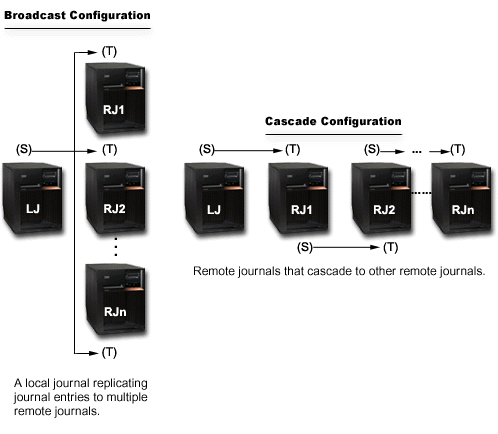Network configurations for remote journals
This topic describes various network configuration for remote journals.
The following figure shows the two basic remote journal function configurations.

A broadcast configuration is a journal that replicates its journal entries to one or more remote journals. A cascade configuration is a remote journal that replicates its journal entries to an additional remote journal. The additional remote journal can replicate the entries to yet another remote journal, and so on. The remote journal function configurations can stand alone or can be combined with one another. For example, one or more of the remote journals in the broadcast configuration could cascade down to several additional remote journals. Likewise, one or more remote journals in the cascade configuration could broadcast out to one or more remote journals.
A local journal is populated by applications that are depositing journal entries. A remote journal is populated by receiving its journal entries from either a local or another remote journal. The journals are paired, as depicted in the preceding figure where (S) represents a journal on a source system, and (T) represents a journal on a target system. In the cascade configuration, a remote journal can be a recipient of journal entries (a target), and a replicator of journal entries (a source) at the same time.
A source system is a system where a journal resides and is having its journal entries replicated to a remote journal on a target system.
A target system is a system where a remote journal resides and is receiving journal entries from a journal on a source system.
A remote journal network includes the local journal and all of the remote journals that are downstream from that local journal. You can set up the remote journal network in broadcast configuration, cascade configuration, or a combination of the two configurations.
In many environments, users attempt to minimize the amount of processing that the local or primary system performs by shifting as much of the processing as possible to other systems in the network. A combination of the broadcast and cascade configurations allows for this when replicating the journal entries from a single system to multiple other systems. For example, replicating a local journal to a single remote journal on a target system will minimize the replication cost on the primary system. Then, from the target system, the replicated journal can be asynchronously replicated by either a broadcast or cascade configuration to other remote journals on other systems. This allows all of the journal entries to be known to all desired systems, while requiring a minimal amount of processing on the primary system.
The following characteristics apply to local journals and to any journal receivers that were attached to local journals:
- Objects can be journaled to local journals.
- Journal entries can be directly deposited to local journals. For example, the Send Journal Entry (SNDJRNE) command or the Send Journal Entry (QJOSJRNE) API can be used to send journal entries directly to a local journal.
The following characteristics apply to remote journals and to any journal receivers that were attached to remote journals:
- Objects cannot be journaled to remote journals.
- Journal entries cannot be directly deposited to remote journals. For example, the Send Journal Entry (SNDJRNE) command or API (QJOSJRNE) cannot be used to send journal entries directly to a remote journal.
- Journal entries are only replicated to remote journals from an associated source journal. A source journal is the journal on the source system to which a remote journal has been added. A source journal can be either a local or a remote journal.
- The information in the journal entries such as time stamps, system name, and qualified journal receiver names reflect information as deposited in the local journal for this remote journal network.
- The information in the journal receiver such as attach time and detach time reflect the information as it is for the local journal for the remote journal network.
- Certain attributes of the remote journal are fixed and determined based on the source journal, such as the values for the journal receiver, manage receiver, manage receiver delay, receiver size options, journal cache, fix length data, threshold, journal object limit, and journal recovery count. These attributes cannot be changed because either they do not apply for a remote journal or they can only be changed by changing the attributes of the source journal.